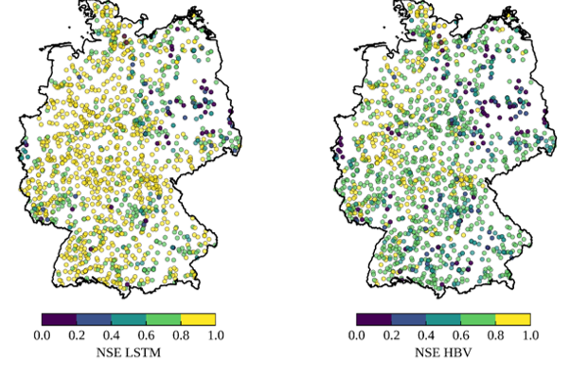Better protection against flash floods through artificial intelligence?
Heavy rainfall and flooding in small river catchment areas (5-500 km²) are among the most serious natural hazards in Central Europe, as was dramatically demonstrated by the Braunsbach flood in 2016, for example. They endanger human lives and cause extensive material damage (Mohr et al., 2023, Ludwig et al., 2023) and therefore represent a highly relevant social challenge. Flood events on this scale occur quickly and locally, which means that warning times are short and the uncertainties of meteorological and hydrological forecasts are high. For this reason, Germany’s federal states usually only publish regional, catchment area or district-based warning levels for smaller rivers and not detailed forecasts.
This is where the joint project KI-HopE-De (Al-supported flood forecasting for small catchment areas in Germany), funded by the BMBF with €1.8 million, is attempting to break new ground. Current research shows that modern machine learning (ML) methods, particularly from the field of deep learning, are able to learn complex relationships in hydrological data sets and thus generate robust and computationally efficient simulations based on hydrometeorological measurement data and numerical weather forecasts. “These models are at least on a par with the physically based models currently used in operational flood forecasting, and in some cases are already superior,” says Dr. Ralf Loritz, the lead PI of the project from the Institute for Water and Environment (IWU) at KIT.

The aim of KI-HopE-De is to increase the accuracy of short-term flood forecasts (up to 48 hours) in small catchment areas through the use of ML methods. The project is based on interdisciplinary and inter-institutional cooperation that combines expertise from the fields of hydrology, meteorology and ML and links university research with operational aspects of state and federal authorities to ensure practical transfer and continuous model operation after project completion. In addition to IWU, the two KIT Institutes for Meteorology and Climate Research Tropospheric Research (IMKTRO, Knippertz) and for Statistics (STAT, Lerch) also participate. The authorities involved are the German Weather Service and the flood forecasting centers of the federal states of Baden-Württemberg, Rhineland-Palatinate, North Rhine-Westphalia and Brandenburg.
KI-HopE-De will develop the first national, ML-based, probabilistic flood forecasting model for small catchment areas in Germany. “We are aiming for a hybrid integration of hydrological and meteorological expert knowledge, existing physical forecast models and ML models in order to create a model architecture that is as robust as possible,” says Prof. Dr. Peter Knippertz from IMKTRO, one of the project PIs. By developing a consistent, transnational model that is trained with extensive data from all over Germany, model stability as well as data and computing efficiency are to be optimized. In addition, KI-HopE-De will create the world's first publicly accessible hydro-meteorological benchmark dataset with extensive measurement and forecast data, which will serve as a basis for the development and comparison of modern hydrological ML forecast models beyond the project.
WG Atmospheric Dynamics
References
Mohr, S.; Ehret, U.; Kunz, M.; Ludwig, P.; Caldas-Alvarez, A.; Daniell, J. E.; Ehmele, F.; Feldmann, H.; Franca, M. J.; Gattke, C.; Hundhausen, M.; Knippertz, P.; Küpfer, K.; Mühr, B.; Pinto, J. G.; Quinting, J.; Schäfer, A.; Scheibel, M.; Seidel, F.; Wisotzky, C., 2023: A multi-disciplinary analysis of the exceptional flood event of July 2021 in central Europe – Part 1: Event description and analysis. Nat. Hazards Earth Syst. Sci., 23, 525–551, doi:10.5194/nhess-23-525-2023.
Loritz, R., Dolich, A., Acuña Espinoza, E., Ebeling, P., Guse, B., Götte, J., Hassler, S. K., Hauffe, C., Heidbüchel, I., Kiesel, J., Mälicke, M., Müller-Thomy, H., Stölzle, M., Tarasova, L., 2024: CAMELS-DE: hydro-meteorological time series and attributes for 1555 catchments in Germany, Earth Syst. Sci. Data, 16, 5625–5642, https://doi.org/10.5194/essd-16-5625-2024.
Ludwig, P.; Ehmele, F.; Franca, M. J.; Mohr, S.; Caldas-Alvarez, A.; Daniell, J. E.; Ehret, U.; Feldmann, H.; Hundhausen, M.; Knippertz, P.; Küpfer, K.; Kunz, M.; Mühr, B.; Pinto, J. G.; Quinting, J.; Schäfer, A.; Seidel, F.; Wisotzky, C., 2023: A multi-disciplinary analysis of the exceptional flood event of July 2021 in central Europe. Part 2: Historical context and relation to climate change. Nat. Hazards Earth Syst. Sci., 23, 1287–1311, doi:10.5194/nhess-23-1287-2023.
